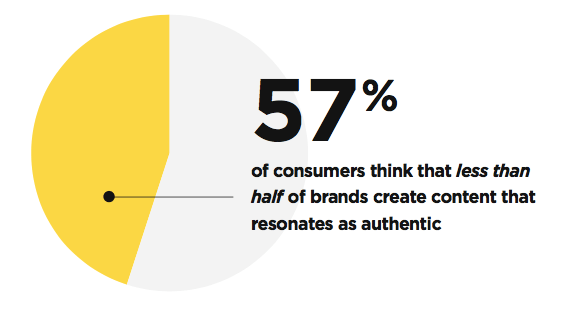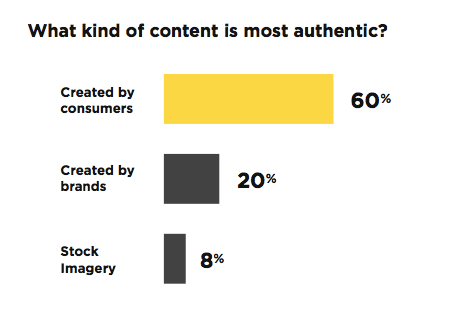Consumers now have more ways than ever to discover, research and purchase products and services. They’re constantly confronted with a myriad of content competing for their attention – but what content and sources do people seek out, trust and find most influential?
Stackla recently conducted their 2017 Consumer Content Report, surveying 2,000 adults in the U.S., UK and Australia to discover what content they create, trust, reference and are influenced by throughout the customer lifecycle.
Here are the key findings.
Authenticity is more important than ever
In a world of celebrity endorsements, sponsored posts and paid influencers, consumers crave authenticity more than ever.

Our survey revealed that 86% of people say authenticity is important when deciding what brands they like and support.
This is especially true of younger generations – who now command $200 billion in annual spending power but are the least engaged with brands.
An overwhelming 90% of Millennials say brand authenticity is important, proving that younger consumers prefer ‘real and organic’ over ‘perfect and packaged’.
Brands can’t fake authenticity
Authenticity has become vital, not only to brand storytelling, but in every part of the customer experience – from advertising to email and everything in between. Unfortunately for most of today’s brands, authenticity is something consumers feel that they’re lacking.

57% of respondents indicated that less than half of brand created content resonates as authentic.
People are not easily fooled either – 70% of the time, consumers are able distinguish between consumer-created content and brand-created content.

And not only can people tell the difference, but they also disconnect with brands that try to fake it. On average, 20% of consumers (and 30% of Millennials) have unfollowed a brand on social media because they felt their content was inauthentic.

So if brands are failing to produce authentic content, what content is seen as authentic in consumers’ eyes?
Consumers consider user-generated content most authentic
Social platforms have become omnipresent, enabling everyone with an internet connection to share their thoughts, experiences and recommendations with the click of a button. Billions of pieces of written and visual content are created by real people on social networks every day – and this is the content consumers find most genuine.

In fact, 60% of consumers said user-generated content (UGC) is the most authentic form of content – 3X more authentic than brand-created content.
And for consumers, authentic content equals influential content.
‘Influencers’ aren’t that influential
Although brands have been buzzing about influencer marketing for a few years now, it turns out celebrities and influencers have the least influence over people’s purchasing decisions.

Our survey found that 60% of consumers (and 70% of Millennials) said social content from friends and family impact their purchasing decisions – while only 23% said celebrity influencer content was impactful.
Considering how much consumers crave authenticity, it should come as no surprise that celebrities and paid influencers are seen as less credible than other content sources – but that’s not to say that online influencers don’t have a role to play in targeted marketing campaigns. They can be an effective way of kickstarting a UGC campaign, particularly for brands that don’t already have a large, active group of advocates.
Consumers fuel a cycle of posting and purchasing
UGC isn’t just being referenced by consumers, it’s actively driving them to make new purchases. Over half of Millennials have made travel plans or decided to eat a restaurant because of consumer-created content they saw on social media.
And once they’ve had a positive travel or dining experience, the vast majority of people are likely to post about it online – 48% of consumers post on social media about places they’ve visited at least twice per month, and 39% of people post about food or beverages at least twice per month.
As our data has shown, this constant stream of content can spark a sense of FOMO (fear of missing out) which can greatly impact people’s purchasing decisions – further fueling the cycle of social influence.
What Does This Mean For Marketers?
Marketers are constantly competing for consumers’ attention, struggling to create enough compelling content to cut through the noise and truly connect with their audiences.
But, as it turns out, most consumers aren’t looking for picture perfect ads or overly produced digital experiences. They want the authentic and trusted content that their friends, family and peers are sharing on social media everyday – organic inspiration and validation.
So give the people what they want. There are massive amounts of influential consumer-created content online, all you have to do is tapped into it.
You can read the full ‘2017 Consumer Content Report: Influence in the Digital Age’ report for more insights.
